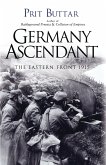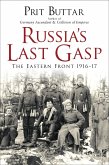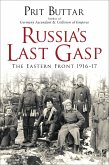A detailed and absorbing narrative of the campaigns fought on the 'forgotten' Eastern Front of the Great War, vividly illustrating that these campaigns were no less costly, tragic and important than the catastrophes of the Somme, Verdun and Passchendaele.
The massive offensives on the Eastern Front during 1915 are too often overshadowed by the events in Western Europe, but the scale and ferocity of the clashes between Imperial Germany, Habsburg Austria-Hungary and Tsarist Russia were greater than anything seen on the Western Front and ultimately as important to the final outcome of the war.
With the Russians hamstrung by weak supply lines and the Austro-Hungarian leadership committed to a strategy of offensive drives despite diminishing manpower and adverse terrain, the fighting in early 1915 was a costly and futile exercise. By the summer, the Central Powers, increasingly dominated by Germany, had begun to gain the advantage, but even the Gorlice-Tarnów Offensive of 1915 - which ultimately resulted in the retreat of Russian forces from Poland - failed to bring the conflict to a conclusion.
Now with the work of internationally renowned Eastern Front expert Prit Buttar, this fascinating story is finally being told. From the bitter fighting in the Carpathian Mountains, to the sweeping advances through Serbia and the almost medieval battle for the fortress of Przemysl, this is a staggeringly ambitious history of some of the most important moments of the First World War.
The massive offensives on the Eastern Front during 1915 are too often overshadowed by the events in Western Europe, but the scale and ferocity of the clashes between Imperial Germany, Habsburg Austria-Hungary and Tsarist Russia were greater than anything seen on the Western Front and ultimately as important to the final outcome of the war.
With the Russians hamstrung by weak supply lines and the Austro-Hungarian leadership committed to a strategy of offensive drives despite diminishing manpower and adverse terrain, the fighting in early 1915 was a costly and futile exercise. By the summer, the Central Powers, increasingly dominated by Germany, had begun to gain the advantage, but even the Gorlice-Tarnów Offensive of 1915 - which ultimately resulted in the retreat of Russian forces from Poland - failed to bring the conflict to a conclusion.
Now with the work of internationally renowned Eastern Front expert Prit Buttar, this fascinating story is finally being told. From the bitter fighting in the Carpathian Mountains, to the sweeping advances through Serbia and the almost medieval battle for the fortress of Przemysl, this is a staggeringly ambitious history of some of the most important moments of the First World War.
In this book Prit Buttar continues his analysis and narrative on what was happening on the Eastern Front in the Great War from his previous Collision of Empires: The War on the Eastern Front in 1914 [Osprey, 2014].
He continues to make the point that most scholars focus on the dreadful suffering and stalemate on the Western Front without any consideration of what was happening on the Eastern Front. This meticulous survey reveals that the Central Powers were making measurable progress to the east with the GoliceTarnow Offensive which led to the retreat of Russian forces from Poland and the occupation of Serbia, being two examples of their advances. These successes were achieved at the expense of massive human losses, basically unreported in the west. However, amidst this success, Prit Buttar does stress that leadership weaknesses on the part of the Central Powers balanced mismanagement on a massive scale by the Russians, leading to an absence of a final success for either side.
Prit Buttar communicates his narrative and associated analysis in a very clear manner. This is a book for scholars with a focused interest. By contrast the enormity of the detail will deter the casual enquirer unless they are carefully guided to begin by exploring the opening and concluding chapters. These very carefully both set the scene and also explain what had happened over that year. With that preparation the interested reader might then explore some or all of the key events of the 1915 campaigns in the east.
Trevor James The Historian 20150901
He continues to make the point that most scholars focus on the dreadful suffering and stalemate on the Western Front without any consideration of what was happening on the Eastern Front. This meticulous survey reveals that the Central Powers were making measurable progress to the east with the GoliceTarnow Offensive which led to the retreat of Russian forces from Poland and the occupation of Serbia, being two examples of their advances. These successes were achieved at the expense of massive human losses, basically unreported in the west. However, amidst this success, Prit Buttar does stress that leadership weaknesses on the part of the Central Powers balanced mismanagement on a massive scale by the Russians, leading to an absence of a final success for either side.
Prit Buttar communicates his narrative and associated analysis in a very clear manner. This is a book for scholars with a focused interest. By contrast the enormity of the detail will deter the casual enquirer unless they are carefully guided to begin by exploring the opening and concluding chapters. These very carefully both set the scene and also explain what had happened over that year. With that preparation the interested reader might then explore some or all of the key events of the 1915 campaigns in the east.
Trevor James The Historian 20150901









